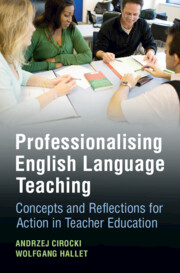Refine search
Actions for selected content:
32 results
2 - Class Matters: The Sociology of the Profession
-
- Book:
- Palestinian Doctors
- Published online:
- 12 September 2025
- Print publication:
- 02 October 2025, pp 36-70
-
- Chapter
- Export citation
Chapter 1 - What is it to become a teacher?
- from Part 1 - Introduction to education
-
-
- Book:
- Introduction to Education
- Published online:
- 14 June 2025
- Print publication:
- 02 June 2025, pp 2-26
-
- Chapter
- Export citation
The Birth and the Unanticipated Evolution of the Public History Movement
- Part of
-
- Journal:
- Public Humanities / Volume 1 / 2025
- Published online by Cambridge University Press:
- 19 December 2024, e30
-
- Article
-
- You have access
- Open access
- HTML
- Export citation

Professionalising English Language Teaching
- Concepts and Reflections for Action in Teacher Education
-
- Published online:
- 24 October 2024
- Print publication:
- 21 November 2024
Crisis as opportunity: legal career paths at two historical turning points in Hong Kong
-
- Journal:
- Law & Society Review / Volume 58 / Issue 3 / September 2024
- Published online by Cambridge University Press:
- 30 October 2024, pp. 481-504
- Print publication:
- September 2024
-
- Article
-
- You have access
- Open access
- HTML
- Export citation
Bioethics: No Method—No Discipline?
-
- Journal:
- Cambridge Quarterly of Healthcare Ethics / Volume 34 / Issue 1 / January 2025
- Published online by Cambridge University Press:
- 22 March 2024, pp. 99-108
-
- Article
-
- You have access
- Open access
- HTML
- Export citation
Chapter 5 - Living ‘in the bosom of a numerous and worthy family’
- from Part II - Spaces of Production
-
-
- Book:
- Female Printmakers, Printsellers, and Print Publishers in the Eighteenth Century
- Published online:
- 14 March 2024
- Print publication:
- 21 March 2024, pp 75-90
-
- Chapter
-
- You have access
- Open access
- HTML
- Export citation
What is attractive about becoming a music teacher? Exploring the motivations of pre-service music teachers towards the profession
-
- Journal:
- British Journal of Music Education / Volume 40 / Issue 3 / November 2023
- Published online by Cambridge University Press:
- 01 December 2023, pp. 311-324
- Print publication:
- November 2023
-
- Article
-
- You have access
- Open access
- HTML
- Export citation
2 - Machiavelli’s World
- from Part I - Machiavelli’s Enterprise and “the World”
-
- Book:
- Machiavelli's Effectual Truth
- Published online:
- 07 September 2023
- Print publication:
- 21 September 2023, pp 33-70
-
- Chapter
- Export citation
1 - The Sources of Qatari Contract Law
-
- Book:
- Contract Law of Qatar
- Published online:
- 15 June 2023
- Print publication:
- 29 June 2023, pp 1-11
-
- Chapter
-
- You have access
- Open access
- HTML
- Export citation
Chapter 2 - Service Magicians
- from Part I - Service Magic in Popular Society
-
- Book:
- Love Spells and Lost Treasure
- Published online:
- 06 January 2023
- Print publication:
- 22 December 2022, pp 73-104
-
- Chapter
- Export citation
37 - Undergraduate Research in Architecture
- from Part III.5 - Arts & Design
-
-
- Book:
- The Cambridge Handbook of Undergraduate Research
- Published online:
- 11 August 2022
- Print publication:
- 07 July 2022, pp 355-362
-
- Chapter
- Export citation
The ‘human element’ in the social space of the courtroom: framing and shaping the deliberative process in mental capacity law
-
- Journal:
- Legal Studies / Volume 42 / Issue 4 / December 2022
- Published online by Cambridge University Press:
- 24 May 2022, pp. 715-734
- Print publication:
- December 2022
-
- Article
-
- You have access
- Open access
- HTML
- Export citation
How should conservation be professionalized?
-
- Article
-
- You have access
- Open access
- HTML
- Export citation
Chapter 9 - Letters
- from Part II - Forms
-
-
- Book:
- Elizabeth Bishop in Context
- Published online:
- 06 August 2021
- Print publication:
- 26 August 2021, pp 105-115
-
- Chapter
- Export citation
1 - Ethics and Engineering
-
- Book:
- Ethics and Engineering
- Published online:
- 14 May 2021
- Print publication:
- 27 May 2021, pp 1-20
-
- Chapter
- Export citation
The interaction effect between gender and profession in posttraumatic growth among hospital personnel
-
- Journal:
- Primary Health Care Research & Development / Volume 21 / 2020
- Published online by Cambridge University Press:
- 24 September 2020, e35
-
- Article
-
- You have access
- Open access
- HTML
- Export citation
Introduction
-
-
- Book:
- Skilled Labour and Professionalism in Ancient Greece and Rome
- Published online:
- 18 September 2020
- Print publication:
- 03 September 2020, pp 1-26
-
- Chapter
- Export citation
Mobile Professionals and Metropolitan Models: The German Roots of Vocational Education in Latin America
-
- Journal:
- European Journal of Sociology / Archives Européennes de Sociologie / Volume 61 / Issue 2 / August 2020
- Published online by Cambridge University Press:
- 01 July 2020, pp. 185-218
-
- Article
- Export citation
Conclusion: putting your best foot forward
-
- Book:
- Building and Sustaining a Teaching Career
- Published online:
- 26 June 2020
- Print publication:
- 26 May 2020, pp 180-186
-
- Chapter
- Export citation
